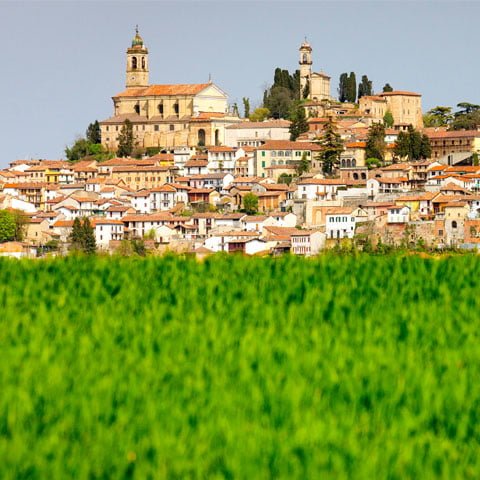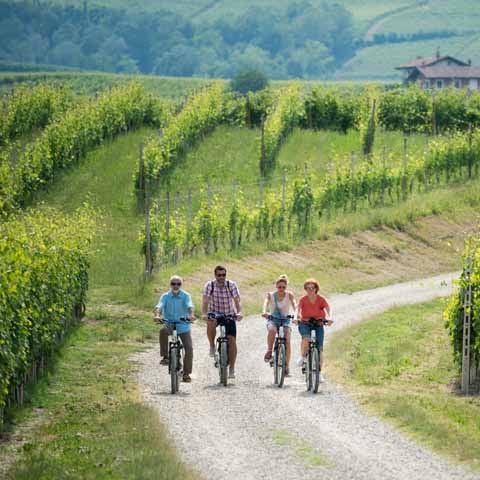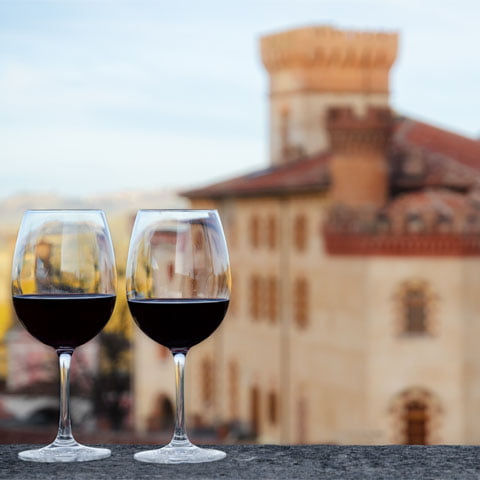Casale Monferrato is a quaint city in the province of Alessandria, in Piedmont, Italy. It is located at the foot of the eastern end of the hills of Po and on the right bank of the homonymous river. Nestled at 381 feet above sea level, the city has always enjoyed a strategic position that gained it the title of the capital of Monferrato.
Today, the city is one of the most active industrial, agricultural, and commercial centers in Piedmont. Throughout its history, Casale Monferrato enjoyed the fame of being one of the most important centers in the country.
It is surrounded by imposing city walls and is characterized by fairly wide and regular streets. Even the oldest parts of the city shine and showcase the importance they had in the past.
The suburbs of the city show off a more modern personality, characterized by gardens, parks, and straight streets that cut at right angles.
One of the most picturesque places here is the castle that stands on the bank of the Po River and overlooks the entire region. But what Casale Monferrato is truly famous for is its interesting history. The territory has been inhabited since antiquity. Fertile and well cultivated, it is a place where vines thrive, especially on the hills.
Agriculture was always part of the local culture; over the centuries, populations passing through these lands engaged in the cultivation of grains, fodder, and rice. Breeding also provided subsistence to the locals and is still practiced in the region.
During the past, Casale Monferrato also gained itself a name as one of the most important wine producing centers in Piedmont. It is known for its Asti-Mortara and Vercelli-Alessandria lines that link the wine-producing regions with the greatest centers in the region, including Turin.
Closely connected with the development of agriculture in general and of viticulture in particular, is also the progress of the industry in the area.
Casale Monferrato is also a remarkable center of studies and hosts one of the first technical institutes ever founded in Italy.
PREHISTORY OF CASALE MONFERRATO
Like many centers in Piedmont, Casale Monferrato boasts a long history that spans many centuries. The first inhabitants to set colonies in the region were the Ligurians, although there are traces that suggest that some other civilizations may have passed through this territory before them.
The Ligurians settled on both banks of the Po River, dividing themselves into tribes.
Some of the most important cultures that shaped the character of the area include the Insubri, but also the Stazielli and the Libui.
Later, the territory was occupied by the Celts who not only settled in the region, but left a long-lasting legacy: their language. In fact, many words used in the local dialect have Celtic origins.
Subsequently, the territory was conquered by the Romans who granted the settlement the status of municipium.
Like most cities that have been granted with the status, Casale Monferrato flourished under the Romans, as is evidenced by numerous remains scattered throughout the territory. Despite this long history though, there is little evidence of prehistoric times in the region.
HISTORY OF CASALE MONFERRATO
Following the barbarian invasions and the fall of the Roman Empire, Casale Monferrato suffered the invasions of the Lombards, who settled in the area in the sixth century AD. Subsequently, the Bishop of Asti converted the settlement to Christianity and laid the foundations of the Church of San Lorenzo that later served as a blueprint for the current cathedral.
The name of Casale appears for the first time in a document of Deacon Andrea at the end of the tenth century. With the beginning of the eleventh century, the city, mostly ignored by the various powers until now, began to assume the institutional structure of a typical medieval urban area.
This led to divergences with the nearby municipality of Vercelli, which culminated in 1215 with the destruction of Casale by an alliance between Vercelli, Asti, Alessandria, and Milan.
Yet despite this unfortunate situation, the citizens recovered quickly and reinforced their city with thick perimeter walls.
By the end of the century, Casale Monferrato became a fairly powerful municipality administered by a general captain. However, due to disputes between the various families, it was decided to appoint Theodore Palaiologos, the son of the Byzantine emperor Andronicus II, as Marquis of Monferrato.
The city remained under the Palaiologos for the entire fourteenth century. Towards the middle of the century, John II ordered the construction of the castle and the reinforcement of the city walls, and after a brief occupation by Visconti, it was returned to Theodore II Palaiologos at the beginning of the fifteenth century.
In the first decades of the century, Marquis Gian Giacomo Palaigolos transferred the capital of the Marquisate of Monferrato to Casale, and during his reign, the city received its first hospital. But it was during the reign of his successor, William III, that Casale Monferrato experienced its maximum flowering.
Under his administration, numerous educational institutes there were also built and many churches were founded.
In 1474, through a bull of Pope Sixtus IV, the Church of Sant’Evasio, the first one erected in the city, was elevated to the rank of Cathedral; this event marked the founding of the Diocese of Casale and the transformation of Casale Monferrato into a true municipality.
Following the Treaty of Cateau- Cambrésis in 1559, Casale passed from the Palaigolos under the dominion of the Gonzaga of Mantua. Under the new rule, the city received new defensive structures.
The settlement flourished mostly under Duke Vincenzo I who built one of the most powerful and prestigious citadels in Europe.
Then, during the counter-reformation period, the city underwent further remarkable transformations. Nevertheless, some of the citizens, including nobles and artisans, rebelled against the absolutist power of Guglielmo Gonzaga, Duke of Mantua and Monferrato, and tried to take control over the city. Their efforts were in vain though, and the duke succeeded in changing the ancient municipal customs towards the end of the sixteenth century.
During the seventeenth century, Casale Monferrato suffered numerous attacks from the Spanish and the French. In the meantime, however, the citadel was constantly reinforced with new defensive structures built in accordance with the most advanced techniques of the time.
The city changed rulers at the beginning of the eighteenth century when Ferdinand Charles of Gonzaga was accused of a felony against the empire. As such, he lost all powers and possessions in favor of his successor, Vittorio Amadeo II, Duke of Savoy.
Under Spanish occupation, Casale suffered serious damage to churches and convents. It also lost its privileges as capital, and all innovative initiatives in the artistic and military fields ended.
From the end of 1798 until May 1799, Casale followed the revolutionary movements taking place throughout Europe in that period and established the republic. However, the city was soon occupied by the Austrians, then by the Russians, where it remained as such until the Battle of Marengo in the following year.
Returned under the French domain once again, the city followed the history of Piedmont but remained surrounded by defensive walls and without any connections to the other bank of the Po River until the middle of the nineteenth century.
The city only received a bridge on August 22, 1840, that was demolished and replaced with a more resistant one after 40 years.
In the meantime, after the suppression of the convents ordered by Napoleon in the first years of the nineteenth century, numerous urban interventions took place including the erection of many sacred buildings and civil edifices that stood as fine examples of neoclassical architecture.
In 1849, during the First War of independence, the Austrians besieged Casale in an attempt to make it a cornerstone of their defensive line. After the middle of the nineteenth century, some of the military works built in the previous centuries were demolished to create space for the new urban enlargements.
These demolition works lasted until 1930 and concluded with the dismantlement of the bridge head.
In the same period though, the city also received many buildings and new infrastructure including sewers, roads, gas and lighting systems, the expansion of the cemetery, and the overpass of the railway line, as well as the arrangement of the public gardens and of a tram system developed to link Casale Monferrato with the neighboring suburbs.
During the beginning of the twentieth century, numerous industrial plants were established, and a regulatory plan to stop illegal construction in the urban areas was approved.
In 1911, heavy artillery barracks were established in the municipal areas; the city was not greatly affected by the World War I, but the outbreak of World War II interrupted the growth of the city, which only resumed after the end of the hostilities.
After the war, Casale Monferrato resumed its expansion, starting with the reconstruction of the bridge over the Po River, which was destroyed by bombs during the war.
The city continued to expand, and new industrial establishments were built. Among them, one of the largest asbestos processing plants in Italy. Over the past few decades, Casale Monferrato continued to invest in its industrial growth, but also started to develop its service sector, focusing majorly on tourism.
ARCHAEOLOGY IN CASALE MONFERRATO
Even if the area of Casale Monferrato, alongside the entire Po River area, was inhabited since the earliest times, there is little archaeological evidence in the region.
Some important artifacts are housed in the Civic Museum of Casale Monferrato; the permanent collection includes a few prehistoric items as well as many findings from the medieval era including pottery and ceramics.
The museum also houses temporary exhibitions, including many archaeological exhibitions of artifacts belonging to the Lombard era. Furthermore, an ethnographic collection embellishes some of the 24 rooms of the museum.
Both in the city and throughout the region, there are also some Roman remains. However, most of these are concentrated in the areas of Tortona, Libarna, and Acqui Terme in the province of Alessandria.
Casale Monferrato, located in the stunning Monferrato Hills, is filled with cultural activities. The city is best characterized by its Baroque architecture and art all surrounded by some of the most beautiful scenery in Northern Italy.Travel Guides
The Piedmont Region of Italy
The Cities of Piedmont, Italy







